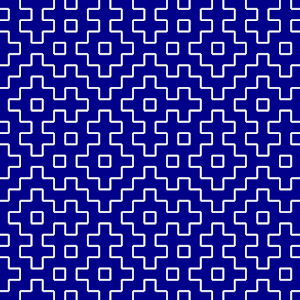Geo-Ban

Geo-ban (거 반) is a Metzettan aesthetic ideal and philosophic concept relating to unity, repetition, imperfection, cohesion and subtle variation. It is present throughout all forms of Metzettan art, culture and society and is formed by the interplay between the two complementary concepts of geo and ban.
Geo-ban is most commonly understood in the west through its visual component which is found in patterns which appear to be formed from identical components which, when examined more closely, are found not to be identical at all, leading seemingly straight lines to form great contours, and apparently well-ordered sets to devolve into randomness. However, in Metzetta it is understood that geo-ban is a characteristic which can be applied to any and all things, from music to society to the universe itself.
It is one of the four heavenly virtues of Kanjinism along with Salajida, Juinui Son and Gwangye.
Etymology

The concept of geo-ban is considered untranslatable in the true sense however the root words from which its name derives can be expounded upon; geo comes from the Metzi word for "almost" while ban comes from "repeating," referring to the primary characteristic of geo-ban wherein seemingly identical components of a whole are understood to be entirely unique upon closer examination.
Geo-ban is a noun but is sometimes erroneously used as an adjective, particularly when discussed in foreign nations; it is not correct to describe something as being geo-ban ("that's so geo-ban!"), only as embodying geo-ban.
Definition
A concise description of the geo-ban worldview is difficult to write due to the many qualities and forms it embodies and the wide scope of its application, however many volumes of text have been written attempting to do exactly this. Geo-ban requires a series of similar units to repeat in an imperfect way, while still forming a cohesive whole and displaying subtle variations which snowball to form huge changes over a large enough number or repetitions. It relates to the distinctiveness of apparently identical things and the impossibility (and often, inferiority) of true perfection.
Geo-ban is seen in the natural world as well as the works of man; it is found on the microscopic scale and the cosmic; it can be seen, heard and experienced in any sense it is possible to feel. It is said that only a natural-born Metzettan raised and taught in the ways of geo-ban can truly understand the world-view it offers, and even then only imperfectly. Students of geo-ban can spend a lifetime reflecting and pontificating upon the beauty and pleasure to be found in everyday items such as apples, bricks, blades of grass, tiles and morning birdsong.
Examples
Geo-ban is perhaps best understood to newcomers by way of listing examples rather than attempting to define ephemeral and abstract qualities. Examples commonly given and considered intuitive to explore and meditate upon include:
- The Forest: Consider the forest itself, the individual trees and the leaves of the trees. Each tree making up the forest is different, and each leaf on each tree may appear at first glance to be identical, but subtly differ in size, colour and additional details such as damage caused by insects. The forest exists only through the contribution of each tree. No tree grows perfectly straight, and the beautiful dappled light found only in the forest would never exist without the leaves.
- The People: At first glance, a crowd of unfamiliar strangers walking through town may blur into one face. The many Emperors may seem overly similar to the uninitiated. The houses on a street may appear to be a row of identical boxes formed from identical plans. However cursory examination reveals the differentiation between each face, each Emperor and each house. Society would never function without the differences between men and their roles in the world. Consider your long, unbroken line of ancestors stretching back to the first man.
- Ceramics: Even a master potter could never create two cups exactly alike; consider a kiln filled with cups created to the same design and reflect upon differences in height, curves, thickness; the potter's fingerprints in different locations upon each cup and the small and unique cracks in each surface. Enjoy the small imperfections in the bowls found in one's own kitchen.
- Text: From a sufficient distance any language devolves into meaningless lines but on closer inspection the meaning becomes clear. Consider a library filled with books of poetry; the repeating yet differing shelves filled with repeating yet differing books filled with repeating yet differing forms filled with repeating yet differing words.
- The Stars: Consider the night sky; filled with seemingly identical points of light, yet each star has a subtly different colour and size, forming groups and constellations. The galaxies themselves form clusters and webs in turn.
- Broth: Consider a master chef cooking many pots of broth to the same recipe on the same day to serve in his restaurant. Each serving of broth would differ almost imperceptibly in flavour, exact ingredients, temperature, even the social surroundings during consumption can affect the "experience" of the broth. This example was popularised through the writings of Kanjin but can be applied of course to any foods.
Stitching technique

A distinctive form of fabric-strengthening and repair emerged following the ideals of geo-ban, constructed from alternating "on" and "off" stitches in a given pattern. Such patterns can be constructed from coin-flips, binary numbers, yes/no questionnaires or simply choosing at whim. These random patterns give rise to unexpected structures.